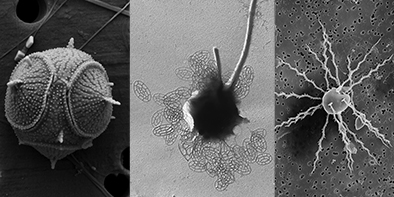
The chrysophytes (Class Chrysophyceae), or golden-brown flagellates, include mostly unicellular, motile and non-motile protists. Freshwater species are more diverse than marine ones, and many form characteristic resting cysts during part of their life cycle. These resting cysts (also called statospores or stomatocysts) have heavily silicified walls, and are thus reasonably resistant to the dissolution processes of aquatic environments. A number of unidentified cysts found in Antarctic seawater samples may represent chrysophyte species.
Cells can be naked, covered in silicified or cellulose scales, or bear a chitinous lorica. They are often spherical to pyriform, but can become distorted following preservation (e.g. in Lugol’s solution). Mixotrophy, when plastid-bearing cells ingest dissolved organic compounds and/or particulate food, is common among the chrysophytes. Being nutritionally opportunistic, this makes them an interesting component of Antarctic microbial communities, particularly during the winter period.
There are 15 species in our key and some can be identified solely by light microscopy (LM) but others may require the use of a scanning electron microscope (SEM) to resolve cryptic features. Primarily we have used common or obvious characteristics such as ‘size’ and ‘shape’ of cells to separate species. Morphological details observed at LM or SEM level are then used to further narrow your results. A thumbnail image of each species is included as a “first impression” and in some cases this can lead directly to a successful identification. Further images can be viewed on the factsheets.
Related Links
Taxonomic names are those used in ‘AlgaeBase’ (accessed April 2013). The following references and weblinks may be useful to the user:
References:
- Kristiansen, J. & Anderson, R.A. (eds) (1996), Chrysophytes: Aspects and Problems. (Cambridge University Press, Cambridge). pp. 337.
- Pienaar, R.N. (1980), Chrysophytes. In Cox, E.R. (ed.), Phytoflagellates (Elsevier-North Holland, New York). pp. 213–242.